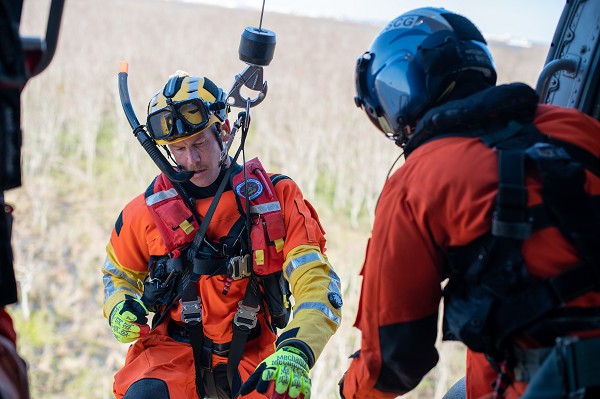
Coast Guard Air Station, New Orleans, LA. (January 26,2023): In this photo by Petty Officer First Class Gabriel Wisdom, rescue swimmer Petty Officer 2nd Class Richard Hoefle is lowered from an MH-60 Jayhawk helicopter by Petty Officer 2nd Class Hunter Simpson, a flight mechanic at Air Station New Orleans. The Coast Guard launched this MH-60 aircrew from Naval Air Station Joint Reserve on missions that included a flyover of New Orleans and emergency landing and hoist training. Every branch of America’s military has a “rescue swimmer” program, but the Coast Guard is unique due to the constant stream of real-life emergencies it faces every day, from rescuing civilians in a hurricane to conducting search and operations rescues far out at sea.
Becoming a U.S. Coast Guard Rescue Swimmer is considered by many to be one of the hardest things one can do in the service. The schooling and physical training are some of the most demanding you will find in any branch of the U.S. Military.
Coast Guard Rescue Swimmers have been called upon in natural disasters like hurricanes and flooding. They routinely handle extreme rescue situations in high seas often involving frantic civilians. A rescue swimmer needs physical strength and endurance, and the mental toughness to ignore their personal safety to save others.
During training, candidates are pushed to their limits as they must survive for 30 minutes in heavy seas as high as 20 feet to pass. Swimmers are pushed to their limits to make sure they have the skills they need to survive.
To become a certified “Rescue Swimmer” (other forces call themselves pararescue), a candidate must pass the following fitness test:
- Pull-ups: 5
- Chin-ups: 5
- Push-ups: 50
- Sit-ups: 60
- 25 Yard Underwater swims: Completed 4 times.
- Buddy Tow: 200 yards
- 500 Yard Swim: Under 12 minutes
This pretty much disqualifies 99 percent of the U.S. population.
Not surprisingly, of the approximately 75-100 Coast Guard personnel who try out each year, the attrition rate is as high as 85%. Once they graduate, simmers join a team of approximately 350 active-duty members stationed around the world. The opportunity to join this elite force is remarkably selective. Since the 1980s, only 900 individuals have achieved high enough scores to become rescue swimmers.
Coast Guard Air Station New Orleans supports a wide range of naval operations to include search and rescue, law enforcement, port security, and marine environmental protection. Air Station New Orleans’ area of responsibility ranges from Apalachicola, Florida to the Louisiana/Texas border, north to Memphis, Tennessee and into the Gulf of Mexico.


